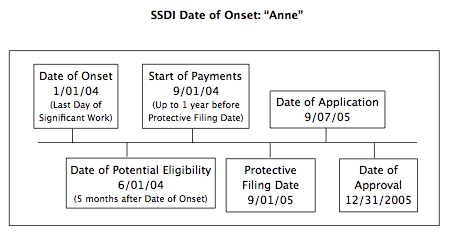Protective Filing Date & Establishing Date of Eligibility
One day can make a significant difference in when the person begins to receive benefits.
About the Protective Filing Date (PFD)
The Protective Filing Date is the date the applicant first contacts SSA indicating an intent to file SSI and SSDI applications. This date is used to determine when an individual can start receiving benefits.
Methods of Establishing the Protective Filing Date
Setting the PFD sets the application process in motion for both SSI and SSDI. This can be done in a variety of ways, each of which has advantages and impacts how the application will be submitted.
- Walk in to SSA without an appointment
- The walk-in date becomes the protective filing date
- Easier for people who have difficulty making and keeping appointments
- SSA claims representative has the advantage of meeting the applicant and can record observations of the their appearance and functioning that can support the application
- Application is completed by SSA
- Call SSA to establish a date for an in-person or telephone interview
- The date of the call becomes the protective filing date
- Avoids long wait times at the SSA office.
- Gives case manager time to gather information and prepare the applicant for what to expect.
- An in-person appointment allows SSA to meet the applicant. The case manager can accompany the applicant to the appointment - this may set them at ease, and you can help provide information.
- A telephone interview avoids possible discomfort with office or agency environment - calls can be made from anywhere the individual feels comfortable.
- Application is completed by SSA
- SOAR Process: Initiate the Online Disability Benefits Application
- Completing sufficient information to save the application and get a re-entry number establishes the protective filing date for both SSI and SSDI.
- Do not proceed beyond the re-entry number screen until you are ready to submit the complete SOAR application packet! Proceeding beyond the re-entry number screen will trigger the local SSA field office to move forward with the application and set an interview date to complete the application. (Step-by-step instructions for initiating the application and getting a re-entry number will be discussed in Class 3).
- The SOAR practitioner then has 60 days to gather information and medical records, write a Medical Summary Report, and submit a comprehensive and complete application packet to SSA.
- Completing sufficient information to save the application and get a re-entry number establishes the protective filing date for both SSI and SSDI.
| Advantages | Walk-In | In-Person Appointment | Phone Interview | Online | SOAR Process |
|---|---|---|---|---|---|
| Establishes protective filing date | ✓ | ✓ | ✓ | ✓ | ✓ |
| Definite time/avoids long wait | ✓ | ✓ | ✓ | ✓ | |
| Time to gather information | ✓ | ✓ | ✓ | ✓ | |
| Comfortable environment | ✓ | ✓ | ✓ | ||
| SSA can meet applicant | ✓ | ✓ |
When to Set the PFD
SSI Eligibility Date
SSA generally sets SSI eligibility as the first day of the full month following the date of application or the protective filing date. This means that the timing of a protective filing date makes a difference and can cost an applicant a month’s worth of benefits!
| Protective Filing Date (PFD) | Eligibility Date |
| October 31 | November 1 |
| November 1 | December 1 |
SSDI Eligibility Date and Date of Onset
SSA uses a different method for determining the eligibility date for SSDI.
- DDS reviews medical information and work activity to establish a date of onset of disability
- Benefit eligibility begins with the date of onset
- Payment begins after a five-month waiting period from the date of onset
- SSDI eligibility date applies not only to SSDI, but (future) Medicare eligibility
SSDI Date of Onset Example:
Anne stopped working on January 1, 2004 due to severe depression. Despite treatment she was unable to return to work. On September 1, 2005 she called SSA to make an appointment, thereby establishing her protective filing date. On September 7, 2005 she completed her application and on December 31, 2005 she was approved. Please see the timeline below to see how Date of Onset impacts Anne's receipt of benefits.

Date Last Insured (DLI)
The Date Last Insured (DLI) is a concept that applies only to SSDI claims.
- The length of time that a person is insured after he or she stops working depends on how consistent a work record he or she has
- The maximum length of time insured status lasts after a person stops working is 5 years
Determination of Insured Status
There are two kinds of insured status a person must have to be eligible for SSDI benefits, fully insured and disability insured.
- To be fully insured, an individual must have 40 quarters (10 years of credited work) or 1 quarter of work credit for each year from age 21 to age of disablement.
- The work need not have been done in any particular year; it must merely meet the required total number of quarters, depending on the claimant’s age.
- To be disability insured, an individual must show a recent connection to the workplace.
- An individual must generally show 20 quarters (5 years of work) in the 40 quarters (10 years of work) immediately preceding when the person stopped working.
- This is also called the “20/40 Rule.”
Details
- Type:
- Adult Course
- Date:
- April, 2017

